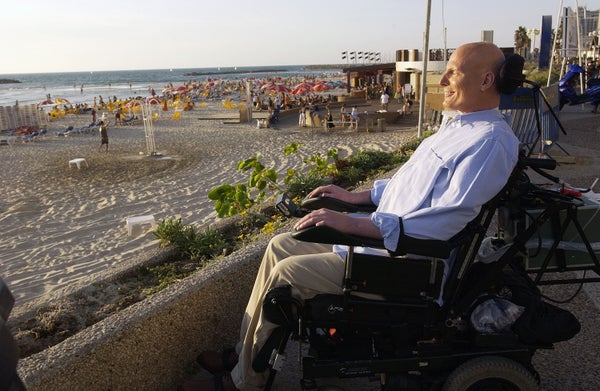In 1995 the late actor Christopher Reeve, who most famously played Superman, became paralyzed from the neck down after a horseback-riding accident. The impact from the fall left him with a complete spinal cord injury at the neck, preventing his brain from communicating with anything below it. Cases like Reeve’s are generally considered intractable injuries, absent any way to bridge the gap to restore disrupted communication lines.
When Reeve died in 2004 a means of reconnection had yet to be built. Now, 14 years later, researchers have coaxed nerve cells to span the divide of a complete spinal cord injury. Their findings, described August 29 in Nature, are specific to only one kind of nerve cell and much work remains before a means of reconnection reaches patients, but the results make an impression. “From the scientific perspective, this is pretty significant,” says Yu-Shang Lee, an assistant professor of medicine at Cleveland Clinic’s Lerner Research Institute, who was not involved in the study. “As far as scientific impact, it is a good leap.”
That leap across a completely compromised spinal cord relied on studies in rats and mice. The research team knew a certain type of nerve cell sometimes helps restore signaling from the spinal cord in partial spinal cord injury. Even when all direct connections to the brain are ruined, these cells can help sustain limited walking function, says Michael Sofroniew, professor of neurobiology at the University of California, Los Angeles, one of the senior authors on the study. He and his colleagues banked on the idea these cells, propriospinal neurons, might do the same if they could grow into an area of complete injury in their experimental animals. So they tried to get these cells to extend their electrical conduction fibers, the axons, into the spinal breach.
On supporting science journalism
If you're enjoying this article, consider supporting our award-winning journalism by subscribing. By purchasing a subscription you are helping to ensure the future of impactful stories about the discoveries and ideas shaping our world today.
Their first effort failed. They tried dampening the activity of a gene called PTEN because the gambit had worked well with a few other types of nonspinal neurons. To their surprise, that strategy did not succeed with the propriospinal cells. They then turned to a set of chemicals that promote nerve cell growth and trigger production of a well-known structural protein called laminin, widely used in tissue engineering as a scaffold. Some of these growth promoters are active in embryonic development, and adults usually do not make them. Previous efforts to coax axons across an injury gap using so-called growth factors alone had come up empty—failures blamed on other inhibitory chemicals getting in the way.
In the current study success came from delivering these chemicals to the propriospinal neurons using laminin as a support material, along with chemical lures to draw regenerating axons to the right place. The team finally coaxed what one of the study’s lead authors—Mark Anderson, a neurobiologist at École Polytechnique Fédéral de Lausanne and U.C.L.A.—calls “an unprecedented amount” of the neuron fibers to bridge the gap. The axons, moreover, were fully capable of passing electrical signals the researchers introduced across the divide. “Now we understand what it takes,” he says, referring to the trifecta of axon growth factors, laminin and chemical bait placed along the path to lure the axon. A long-term goal stemming from these results is to figure out how to take their complex, three-part protocol and make it something useful for patient care.
Sofroniew, however, expresses caution in talking about actual treatments just yet. This study, he says, is a first step, a demonstration that the three-pronged approach could work. It’s also likely the protocol they devised for propriospinal neurons will not be adaptable for other kinds of neurons that make up the spinal cord. Just as the first tricks they tried for propriospinal neurons did not work, “I very much suspect that we might need different combinations or combinations of different things for different populations of neurons,” he says. The neurons involved in their study “will be able to restore certain functions, like control of stepping, but perhaps not others,” he notes. “We’ll have to see.”
Bridging the gap is really just a beginning. The regenerated axons need to communicate with pathways around the injury so traffic, consisting of signals from the brain and spinal cord moving through restored connections at the injury site, can flow. The researchers suggest the way to restore that flow is via rehabilitation targeted at the new axons generated by exposure to their protocol.
The need for rehabilitation was underlined by the finding that the animals in their study did not have their locomotion abilities suddenly restored once axons bridged the injury gap. Rehabilitation entails training freshly regenerated axons to execute their new duties. Anderson compares it with a child learning to walk. “A baby doesn’t just spontaneously stand up and walk,” he says. As with achieving those first toddler steps, rehabilitation “requires training, it requires repetition, it requires engaging these regenerating axons.”
Rehabilitation can take many forms, Sofroniew says, from simple repetition of movements with support from a therapist to using electrophysiological activation and movement training. The team plans to take their spinal cord injury repair protocol and combine it with different kinds of rehabilitation as a next step.
Devising the needed protocols will take time. “Quite a bit of work needs to be done before clinical application,” Cleveland Clinic’s Lee says, and coupling of repaired axons and rehabilitation must be considered “no matter what type of repair strategy you use.”
“As a field, we are just beginning to understand how to facilitate this with appropriately targeted rehabilitation,” Sofroniew notes. Now his team wants to see “if we can, with rehabilitation training, reboot the whole system.”
